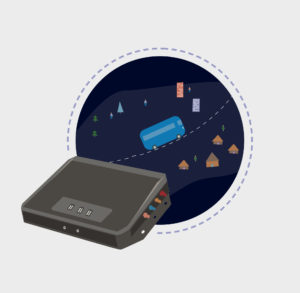We recently sat down with Passenger Transport to discuss our latest ‘Connected Bus’ concept, as well as revealing all about our new product, the Smart Gateway.
You can read the full feature below or alternatively visit www.passengertransport.co.uk to read the article.
The last couple of decades have seen the bus becoming a lot smarter. Even the most basic vehicles are now equipped with a whole host of cutting-edge technology systems, from ticket vending and CCTV, through to telematics, Passenger Occupancy, real-time information and more.
 All of these disparate pieces of technology have their own evolution paths and whilst most functions on that technology are specific to the core use case of that system, there can also be a lot of overlap where each supplier has introduced the same core technology – GPS is one such example. Ticketer Co-Founder John Clarfelt believes the time is right to start bringing those different solutions and platforms together in a way that will benefit suppliers, bus operators and passengers alike.
All of these disparate pieces of technology have their own evolution paths and whilst most functions on that technology are specific to the core use case of that system, there can also be a lot of overlap where each supplier has introduced the same core technology – GPS is one such example. Ticketer Co-Founder John Clarfelt believes the time is right to start bringing those different solutions and platforms together in a way that will benefit suppliers, bus operators and passengers alike.
This philosophy forms the bedrock of Ticketer’s new Connected Bus concept.
“Ticketer started its journey with a humble ticket machine but has grown from that” explains John. “There’s now a whole raft of features associated with our ticketing devices, that are not to do with ticketing.”
He explains that the company increasingly started to think of its technology as the nascent hub of the bus. That process began some years ago when Schedule Adherence technology was introduced to Ticketer’s range of products. Since then, Ticketer has integrated other features, such as its recent Road Restriction Alerts feature, to create a single solution and to help streamline operations and bring greater benefits to customers.
 The Connected Bus introduces a new platform that extends this principle and opens the hub to a whole raft of ancillary systems, which can be plugged into the Connected Bus to give an overarching view of what’s happening on that vehicle at any given time. It might be CCTV or telematics for example, and Ticketer’s platform can bring these systems together and support the entire ecosystem.
The Connected Bus introduces a new platform that extends this principle and opens the hub to a whole raft of ancillary systems, which can be plugged into the Connected Bus to give an overarching view of what’s happening on that vehicle at any given time. It might be CCTV or telematics for example, and Ticketer’s platform can bring these systems together and support the entire ecosystem.
“From the passenger perspective, in our fast-paced society they expect timely services that offer convenient and efficient ways to travel”
“It means that operators can see what’s happening on their vehicles via a single view,” adds John. “So, say they want to add some new technology or another function to that vehicle, they can minimise the amount of additional hardware or SIMs onboard – or even just take the relevant data feed – and enable other suppliers to deliver swathes of new functionality at minimum cost. With Ticketer’s platform already onboard, we have a resilient infrastructure system that updates operators in real-time, so why not use that system to benefit everyone – operators, passengers, and suppliers alike?”
 “The whole concept is about making things more cost-effective and resilient, while also adding more features and functionality to expand the data sets you have access to, and the analysis thereof, that benefits both passengers and the operator” notes Jason Mann, Ticketer’s Head of Product.
“The whole concept is about making things more cost-effective and resilient, while also adding more features and functionality to expand the data sets you have access to, and the analysis thereof, that benefits both passengers and the operator” notes Jason Mann, Ticketer’s Head of Product.
“By using a single platform with a shared communications channel for all onboard systems, there are other benefits that can be gained, principally the data that each system generates can be shared amongst the wider ecosystem and that then drives real value. How? Well thinking back to that passenger counting system, typically that data would be sent to the supplier’s back office. However, there are other systems on the vehicle that could make use of that data. A great example of this in practice is when we integrated our Passenger Occupancy data onto the destination displays, so passengers at the bus stop can see how full the bus is as the bus approaches. There are other examples that could equally provide added benefit. For example, with CCTV, Ticketer have an “incidents” feature that allows drivers to capture various events. That data could be enhanced with an image from each CCTV camera when that event is issued, rather than the operator having to mine two separate and distinct systems.”
Jason continues: “If you take data from telematics and data from a Passenger Occupancy system, why has the vehicle’s power consumption gone up? Well, it’s down to the fact you’ve got a full bus, which means it is heavier and needs more power to move. That data can also be shared externally, for example to the operator’s customer app, rather than just using the data internally. If we go back to the example of the Passenger Occupancy system, that data could also be made available to the app, so passengers know whether their bus is currently running at full capacity or empty. There are so many possibilities offered by the Connected Bus.”
“What’s good for the operators is ultimately good for the passengers.”
 Looking to the future, nobody can predict how technology will evolve. After all, see how rapidly on-vehicle technology has developed over the last couple of decades. Brad Todd, Ticketer’s Director of Product Strategy and Customer Success, believes this process of innovation will only continue to grow, and the Connected Bus concept means those new features and developments can be plugged in and connected in a single standardised way, helping to future-proof business operations.
Looking to the future, nobody can predict how technology will evolve. After all, see how rapidly on-vehicle technology has developed over the last couple of decades. Brad Todd, Ticketer’s Director of Product Strategy and Customer Success, believes this process of innovation will only continue to grow, and the Connected Bus concept means those new features and developments can be plugged in and connected in a single standardised way, helping to future-proof business operations.
CONNECTED BUS STREAMLINES PROCESSES
- By utilising just one SIM card or antenna on the vehicle, operators can reduce costs and maintenance of systems. There are also opportunities to reduce energy consumption.
- By connecting individual disparate systems, operators can leverage their assets by connecting them up – the whole is greater than the sum of the parts.
- By creating a single view both on the bus and in the back office far richer data sets can be created that can improve the information provided to both the driver and the passenger.
 This means that all data outputs will also be standardised, with Ticketer being able to offer a platform that allows the ecosystem to evolve over time and make use of the data. It creates that in the best and most effective way possible. “It becomes a much more powerful entity when you put all those bits together as one,” adds Brad.
This means that all data outputs will also be standardised, with Ticketer being able to offer a platform that allows the ecosystem to evolve over time and make use of the data. It creates that in the best and most effective way possible. “It becomes a much more powerful entity when you put all those bits together as one,” adds Brad.
Ticketer’s approach to the Connected Bus concept is not to be the “master of all”. “We don’t want to try and be the experts of everything,” John comments. “There are lots of very good suppliers out there that are specialists in their fields, so there isn’t the need, or ability, for one company to do it all. Instead, this platform delivers the ability to bring it all together and align partners towards a common goal for the greater good.”
“What’s good for the operators is ultimately good for the passengers,” concludes John. “We want to create the tools and ability for operators to be masters of the data. Is the whole greater than the individual parts? I think it is.”

